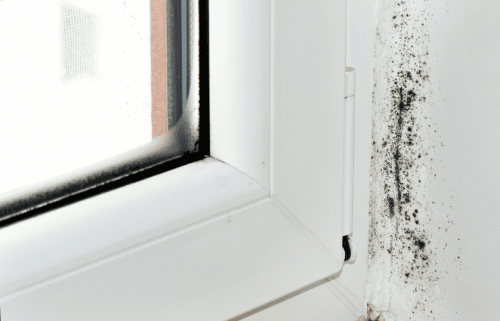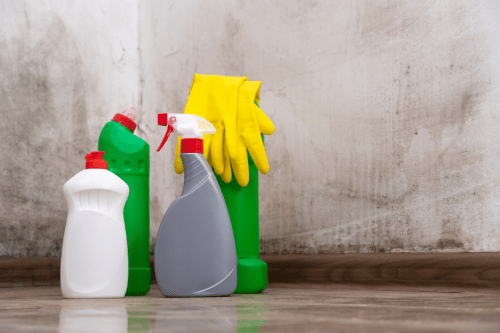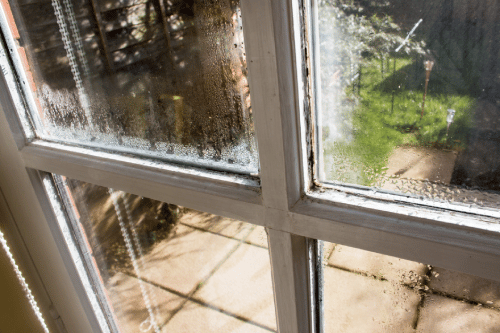Black mold is bad news. So if you’ve noticed little black dots and growths starting to form on your window sill, you might be understandably concerned. Without treatment, black mold on your windows will keep growing and eating away at your frames. Left to its own devices, it can even get into your walls and HVAC system, quickly spreading throughout your home.
It’s time to take action. Many types of black mold are toxic, and can cause serious damage. The good news? If you’ve spotted the mold early, it’s possible to contain it on your own. With a little strategic cleaning and assessing, you can breathe easy.
In this piece, we’ll share exactly what black mold is, what causes it, and how to eliminate it from your home.

What is black mold?
The term “black mold” is a catch-all for many different varieties of microfungus. Also known by the Latin name Stachybotrys chartarum, this mold loves to feed on building materials like wallpaper, drywall, vinyl, and wood.
While it can’t technically grow on glass, mold can attach itself to the dust on your glass and grow there. If you have double-pane windows, you may even notice mold between your window panes. Molds have a very thin thread system that acts like the roots of a plant. These thin threads can spread mold deep, and cause an outbreak to spread quickly if left unchecked.
What causes black mold on window sills?
When thinking about mold, old and rotting fruits and vegetables usually come to mind. That’s because molds love growing on organic materials, and can’t survive without some form of water. So when mold starts to grow on your window sills, excess moisture is usually the issue.
But where does this moisture come from? A few culprits may be to blame.
Condensation
The temperature difference between the outside and the indoors can cause condensation on your windows. That condensation can form into water drops that roll down onto your sill. When those water droplets heat up in the sun, they create the perfect environment for spores to grow.
Some rooms in our homes are more humid than others, and more susceptible to mold growth. That steamy bathroom shower or big pot of boiling pasta water in the kitchen will cause your windows to fog up and could lead to an outbreak of black mold.

Leaking windows
If you have a cracked pane of glass, it’s not just a cosmetic issue. That crack could be a place where moisture is gathering, making it the perfect spot for mold spores to grow and flourish. Be aware that mold can also be the result of a window that doesn’t close quite right. If you have a window that always feels drafty, it’s not just outside air that’s sneaking into your home—moisture could be coming in as well. Leaking windows are breedings grounds for black mold.
Flooding or heavy storms
When water goes where it shouldn’t, mold usually follows close behind. Act fast whenever you suspect a plumbing issue has caused water to leak into your walls. Plumbing issues can eventually become mold issues. If you have a basement that floods during inclement weather, attend to the water as quickly as you can and dry out the space thoroughly.
It’s unfortunate, but true: if you’re treating an area for water damage, you can anticipate treating for mold.
Is black mold on window sills dangerous?
Black mold can make you sick
For the sake of safety, assume that any mold you have is toxic. According to the Environmental Protection Agency (EPA), molds produce allergens, irritants, and even toxic substances like mycotoxins. They are harmful to breathe and harmful to touch.
Some of the symptoms of mold exposure include:
- Shortness of Breath: Mold seriously affects the respiratory system. If it takes more effort to inhale and exhale, or you are noticing a tickle in your lungs and throat, you could be suffering from exposure to mold. Children, whose lungs are still developing, are especially vulnerable.
- Cold-like Symptoms: Your standard-issue seasonal cold symptoms like nasal congestion, a runny nose, coughing, or sneezing may be signs of mold exposure.
- Headaches: If you notice the number of headaches you experience increasing, mold could be to blame. Even if painkillers take the edge off, the constant exposure to mold will bring the headache back.
- Skin Rashes: If you’re noticing that you’re more susceptible to skin rashes and dryness, mold could be the culprit. While topical creams and medication may temporarily give you relief, until you remedy your mold outbreak, the skin irritation will continue.
- Anxiety and Depression: Though it’s a lesser-known symptom, mold can have a significant effect on mental health. According to Psychology Today, mold could be to blame for your racing mind, overthinking, depersonalization, or panic attacks. Mold exposure has also been linked to moderate and even mild depression.
If you want to know exactly what type of black mold you are dealing with, you’ll have to take a sample and send it out to a lab. But for the sake of your family’s health, it’s best practice to eliminate mold as soon as you spot it.

Black mold can cause structural damage
That black mold on your windows is a living thing that grows by digesting the organic materials around it. If left unstopped, it will eventually destroy whatever it lands on, and continue to expand outward. The frames of your windows will deteriorate, then it may spread into your drywall and into the structural components of your home.
If the mold spores become airborne, they can start to grow and hide out in unexpected places. It’s not unusual to find mold in fabric, couches, mattresses, or lampshades.
If you have mold between your double-paned windows, the seal is broken on your window. With a broken seal, that window is no longer energy efficient. You are spending extra money every month on heating and cooling.
As soon as you spot mold in your home, you should take steps to clean it—otherwise it can become an expensive and damaging problem.
How to clean black mold on window sills
Gather your materials
When you are ready to dive in, assemble the following materials:
- Protective Clothing:
- Safety goggles
- Rubber Gloves
- N-95 respirator mask
- A small hand-held vacuum
- Cloth to wipe down the area
- Spray bottle with cleaning solution

Choose your cleaning solution
There are a few different options for cleaning solutions. White distilled vinegar will kill about 80% of mold species on contact. If you’d like to increase the potency of your solution, you can make a paste of vinegar and baking soda. Mix one part vinegar with two parts baking soda to create your paste.
Depending on what type of surface you’re cleaning, you may be able to use bleach. If you’d like to use bleach, mix ¼ to ½ cup of bleach in a gallon of water to create your cleaning solution.
You may also choose a commercial mold cleaning compound. Ask the folks at your local home store what they recommend. As always, don’t mix different commercial cleaning solutions together. You could release toxic gas into your home.
Do a preliminary clean
If you’re in a room with an exhaust fan, go ahead and turn that on. If you have a HEPA filter, it’s probably a good idea to keep it working alongside you while you clean. Don your protective gear, and start up your handheld vacuum. Taking a light suction to these areas will reduce the chance of spores becoming airborne and traveling to a different area of your home. Get rid of any loose debris around the mold
Pro tip: When it’s time to empty the canister in your vacuum, make sure you do this outside.
Treat the affected area
Next, saturate the mold with your preferred cleaning solution. You want all those spots of mold to come in contact with your cleaning solution. Take your cloth and give the area a gentle rub. It can be tempting to scrub, but if you put too much muscle into it, you can work the mold spores deeper into your window frames.
Allow your windows to dry completely
Cleaning solutions need time to do their work—now it’s time for you to walk away. Throw out the cloth you used to clean the mold, and leave your windows open. Let the area dry completely. Check back every few days to make sure the mold hasn’t returned.
Consider calling in the pros
If you’re unable to clean the mold yourself, you can always call in a mold remediation and removal specialist. They’ll know exactly how to get rid of your mold issues and they’ll work to ensure that you won’t experience recurrences.
Note: If you have a mold outbreak larger than 10 square feet, you’ll want to be sure to enlist a professional.
How to prevent black mold on windows
Find and eliminate the cause
When you’ve taken care of the black mold on your windows, you’ll want to know how to prevent mold from returning in the future. Start by doing a little investigative work to ensure you don’t have any larger issues.
Mold could come from:
- Leaking roof. Is your roof still draining stormwater properly?
- Leaking pipes. Is there an issue with your plumbing that is causing water to gather somewhere in your home?
- Heating and ventilation system problems. Is there an issue with the air flow or humidity in your home?
- Damaged window frames/window seals. Is it time to replace your home windows? If the seals on your windows have worn out, your home becomes more drafty and expensive to keep comfortable. A leaky window brings in extra moisture, which can lead to mold outbreaks.

Prevent black mold with healthy habits
With a few simple practices, you can prevent black mold from returning.
- Keep your home thermostat around 70 degrees. This is the magic number that experts say inhibits mold growth.
- When you go out of town, remember to keep the air on. A feeling of mustiness is often the early signs of a mold outbreak.
- Open the windows to bring in fresh air.
- Limit the amount of plants you keep on your window sill. Plants can create micro-biomes with higher humidity, which encourages mold growth.
- Run the fans in the bathroom when you shower.
- Use your kitchen exhaust fan while you cook.
- Consider running a dehumidifier.
- If you notice you have a drafty or leaky window, fix it right away.
- Keep the air circulating in your home. A home with regularly circulating air is excellent for your health, and will prevent mold from returning.
Check your window warranty
If your mold outbreak is traceable back to a drafty or broken window, check to see if your windows are covered under warranty, and replace them as soon as possible. An up-to-date, working window is an excellent line of defense.
Should you call in the professionals?
If you’ve done DIY mold extermination with vinegar or bleach and your mold returns, it may be time to call in the professionals. Mold remediation experts can let you know if the mold has spread into your sheetrock under your window sills or into the drywall. Mold can hide in the most unlikely places, and if you have health concerns, it’s time to let a professional take over.
If your mold outbreak is traceable back to worn out windows, contact Window Nation today. Mold that has sat on your window may have deteriorated the seal or frame. A new set of replacement home windows will increase your home energy efficiency and ensure that no new mold outbreaks occur. Window Nation’s professional installers can assess the condition of your windows and give your home a fresh new start. Give us a call for a free quote today!


